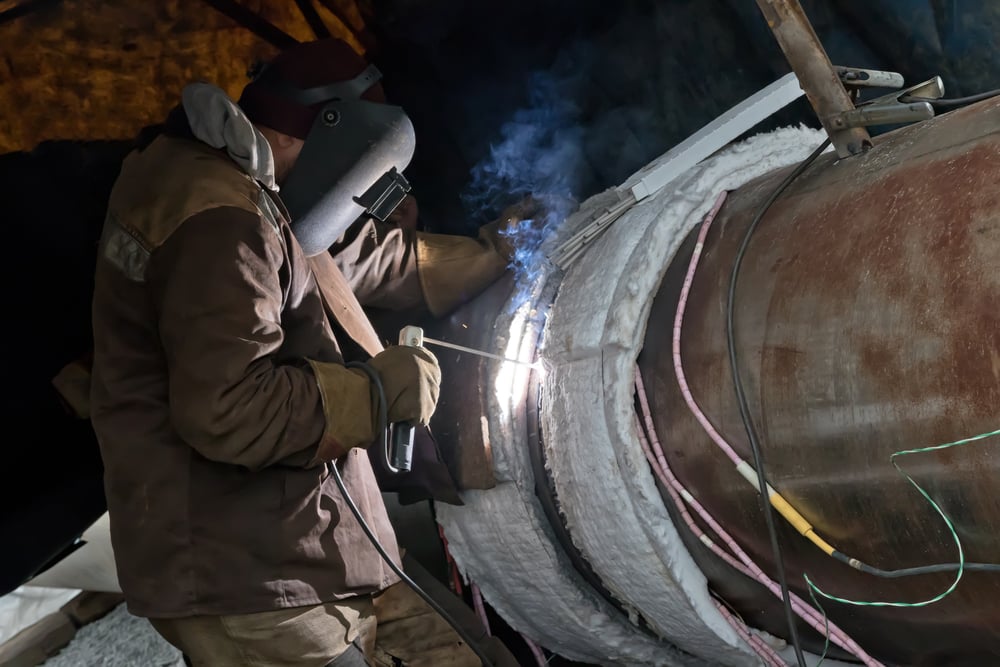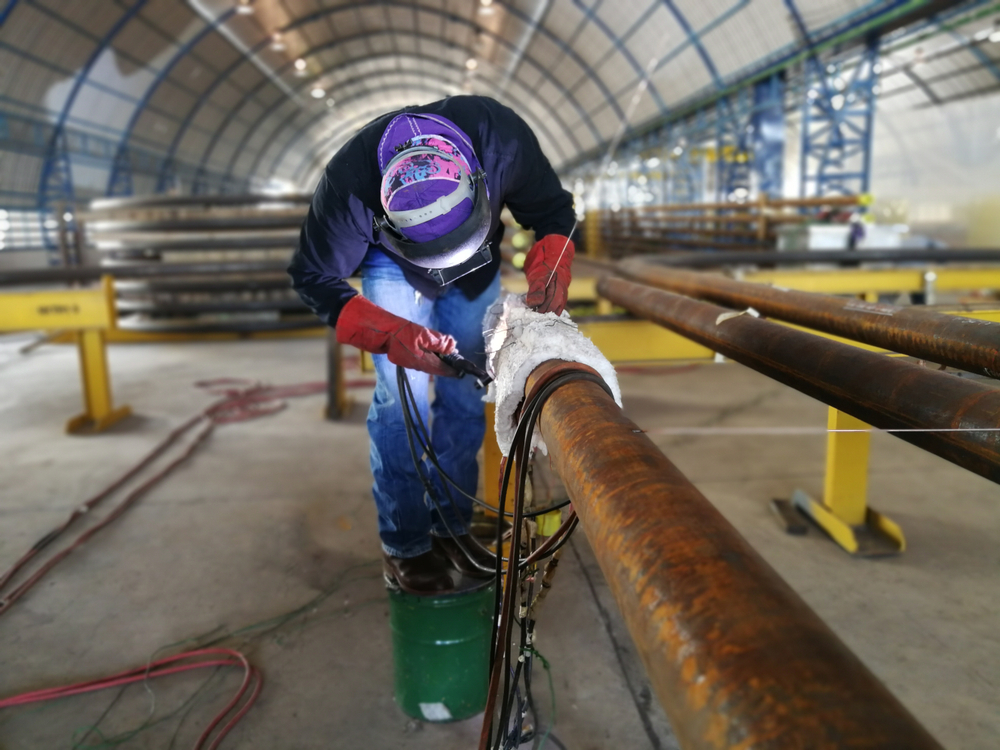Pre-heating is sometimes required before welding, learn why!
Preheating the base material to be welded minimises the temperature difference between the material and the arc. This slows the cooling rate in the weld area and reduces the risk of cracking.
Overview.
The need for pre-heating when welding increases with steel thickness and weld restraint. Plus, the carbon/alloy content of the steel and the diffusible hydrogen of the weld metal.
Pre-heat is commonly applied with fuel gas torches or electrical resistance heaters.
Although as a process it can seem expensive, it can save time and costs in the long term by reducing risk of a failed weld.
The purpose of preheat.
- Reduce the risk of hydrogen cracking
- Reduce the hardness of the weld heat affected zone
- Reduce shrinkage stresses during cooling, and improve the distribution of residual stresses.
If preheat is locally applied it must extend to at least 75mm from the weld location, and preferably measured on the opposite face to the one being welded.
Industries that commonly require the benefits of preheat treatment in both shop and field applications are:
- oil and gas
- power plants
- structural fabrication
- transmission pipelines
- ship building, among others.
Heat treatment of welded joints.
Heat treatment is an operation that is both time consuming and costly.
It can enhance the strength and toughness of a welded joint, its corrosion resistance and the level of residual stress. It is also a mandatory operation specified in many application codes and standards.
In addition, it is an essential variable in welding procedure qualification specifications.
Heat treatment terms.
Here we define what is meant by the various terms used to describe the range of heat treatments that may be applied to a welded joint. Such terms are often used incorrectly, particularly by non-specialists. But for a metallurgist, they have very precise meanings.
The best method for a specific application depends on job variables including material thickness, size and project timeline. Budget and knowledge level of available personnel are also things to consider.

Solution treatment.
Carried out at a high temperature and designed to take into a solution elements and compounds. These are then retained in solution by cooling rapidly from the solution treatment temperature.
This may be done to reduce the strength of the joint or to improve its corrosion resistance.
With certain alloys, it may be followed by a lower temperature heat treatment to reform the precipitates in a controlled manner (age or precipitation hardening).
Annealing.
This consists of heating a metal to a high temperature, where recrystallisation and/or a phase transformation take place. It’s then cooled slowly, often in the heat treatment furnace.
Often carried out to soften the metal after it has been hardened. For example by cold working; a full anneal giving the very softest of microstructures.
It also results in a reduction in both the yield and the tensile strength. And, in the case of ferritic steels, usually a reduction in toughness.
Normalising.
This is a heat treatment that is carried out only on ferritic steels.
It comprises heating the steel to some 30-50°C above the upper transformation temperature, (for a 0.20% carbon steel this would be around 910°C) and cooling in still air.
This results in a reduction in grain size and improvements in both strength and toughness.
Quenching.
This comprises a rapid cool from a high temperature.
A ferritic steel would be heated to above the upper transformation temperature and quenched in water, oil or air blast. Thus producing a very high strength, fine grained martensite.
Steels are never used in the quenched condition, they are always tempered following the quenching operation.
Tempering.
A heat treatment carried out on ferritic steels at a relatively low temperature, below the lower transformation temperature. In a conventional structural carbon steel this would be in the region of 600-650°C.
It reduces hardness, lowers the tensile strength and improves ductility and toughness.
Most normalised steels are tempered before welding. All quenched steels are used in the quenched and tempered condition.
Ageing or Precipitation Hardening.
A low temperature heat treatment designed to produce the correct size and distribution of precipitates, thereby increasing the yield and tensile strength.
It is generally preceded by a solution heat treatment.
For steel, the temperature may be somewhere between 450-740 degree C, an aluminium alloy would be aged at between 100-200°C.
Longer times and/or higher temperatures result in an increase in size of the precipitate and a reduction in both hardness and strength.
Stress Relieving.
As the name suggests, this is a heat treatment designed to reduce the residual stresses produced by weld shrinkage. It relies upon the fact that, as the temperature of the metal is raised, the yield strength decreases. Thus allowing the residual stresses to be redistributed by creep of the weld and parent metal. Cooling from the stress relief temperature is controlled in order that no harmful thermal gradients can occur.
Post Heat Treatment.
A low temperature heat treatment carried out immediately on completion of welding. Done by increasing the preheat by some 100°C and maintaining this temperature for 3 or 4 hours.
This assists the diffusion of any hydrogen in the weld or heat affected zones out of the joint, and reduces the risk of hydrogen induced cold cracking.
It is used only on ferritic steels, where hydrogen cold cracking is a major concern i.e. very crack sensitive steels, very thick joints etc.
Post Weld Heat Treatment (PWHT).
So what does the term ‘post weld heat treatment’ mean?
To some engineers, it is a rather vague term that is used to describe any heat treatment that is carried out when welding is complete.
To others however, particularly those working in accordance with the pressure vessel codes (BS PD 5500, EN 13445 or ASME VIII), it has a very precise meaning.
Heat treatment following welding may be carried out for one or more of three fundamental reasons:
- to achieve dimensional stability, in order to maintain tolerances during machining operations or during shake-down in service.
- to produce specific metallurgical structures in order to achieve the required mechanical properties.
- to reduce the risk of in-service problems, such as stress corrosion or brittle fracture, by reducing the residual stress in the welded component.
The range of heat treatments to achieve one or more of these three objectives, in the range of ferrous and non-ferrous metals and alloys that may be welded, is obviously far too extensive to cover in great detail within these brief Job Knowledge articles.
PWHT Summary.
The emphasis in the following section will be on the PWHT of carbon and low alloy steels as required by the application standards. Although brief mention will be made of other forms of heat treatment that the welding engineer may encounter in the ferrous alloys.
There are two basic mechanisms that are involved, firstly stress relief and secondly micro-structural modifications or tempering.

Stress Relief.
Why is it necessary to perform stress relief?
It is an expensive operation requiring part or all of the welded item to be heated to a high temperature, and it may cause undesirable metallurgical changes in some alloys.
As mentioned above there may be one or more reasons.
The high residual stresses locked into a welded joint may cause deformation outside acceptable dimensions to occur when the item is machined or when it enters service.
High residual stresses in carbon and low alloy steels can increase the risk of brittle fracture, by providing a driving force for crack propagation.
Residual stresses will cause stress corrosion cracking to occur in the correct environment. For example, carbon and low alloy steels in caustic service or stainless steel exposed to chlorides.
What causes these high residual stresses?
Welding involves the deposition of molten metal between two essentially cold parent metal faces.
As the joint cools the weld metal contracts, but is restrained by the cold metal on either side; the residual stress in the joint therefore increases as the temperature falls.
When the stress has reached a sufficiently high value (the yield point or proof strength at that temperature), the metal plastically deforms by means of a creep mechanism. The stress in the joint now matches the yield strength.
As the temperature continues to fall, the yield strength increases, impeding deformation. At ambient temperature, the residual stress is often equal to the proof strength (Fig 1).
To reduce this high level of residual stress, the component is reheated to a sufficiently high temperature.
Reducing residual stress.
As the temperature is increased, the proof strength falls. This allows deformation to occur and residual stress to decrease until an acceptable level is reached.
The component would be held at this temperature (soaked), for a period of time until a stable condition is reached, and then cooled back to room temperature.
The residual stress remaining in the joint is equal to the proof strength at the soak temperature.
Figure 1 shows that residual stress in a carbon manganese steel falls reasonably steadily from ambient to around 600 degree C. However, high-strength, creep-resistant steels need to be above 400 degree C before the residual stress begins to fall.
Stainless steel is hardly affected until the temperature exceeds 500 degree C. There is therefore, a range of soak temperatures for the various alloys to achieve an acceptable reduction in residual stress, without adversely affecting the mechanical properties of the joint.
In carbon manganese steels, this temperature will be between 550-620 degree C, in creep resistant steels somewhere between 650-750 degree C, and for stainless steels between 800-850 degree C.
More information can be found on the TWI knowledge web site
We have a variety of machines and brands in stock for your heating applications, with further solutions available on request. Brands include Stork Cooperheat, AEC, Globe and our range of new heating equipment.



